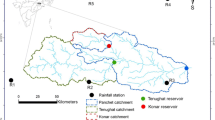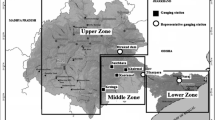Abstract
In this paper, bootstrapped wavelet neural network (BWNN) was developed for predicting monthly ammonia nitrogen (NH4+–N) and dissolved oxygen (DO) in Harbin region, northeast of China. The Morlet wavelet basis function (WBF) was employed as a nonlinear activation function of traditional three-layer artificial neural network (ANN) structure. Prediction intervals (PI) were constructed according to the calculated uncertainties from the model structure and data noise. Performance of BWNN model was also compared with four different models: traditional ANN, WNN, bootstrapped ANN, and autoregressive integrated moving average model. The results showed that BWNN could handle the severely fluctuating and non-seasonal time series data of water quality, and it produced better performance than the other four models. The uncertainty from data noise was smaller than that from the model structure for NH4+–N; conversely, the uncertainty from data noise was larger for DO series. Besides, total uncertainties in the low-flow period were the biggest due to complicated processes during the freeze-up period of the Songhua River. Further, a data missing–refilling scheme was designed, and better performances of BWNNs for structural data missing (SD) were observed than incidental data missing (ID). For both ID and SD, temporal method was satisfactory for filling NH4+–N series, whereas spatial imputation was fit for DO series. This filling BWNN forecasting method was applied to other areas suffering “real” data missing, and the results demonstrated its efficiency. Thus, the methods introduced here will help managers to obtain informed decisions.










Similar content being viewed by others
References
Abaurrea J, Asín J, Cebrián AC, García-Vera MA (2011) Trend analysis of water quality series based on regression models with correlated errors. J Hydrol 400(3–4):341–352
Adamowski J, Chan HF (2011) A wavelet neural network conjunction model for groundwater level forecasting. J Hydrol 407:28–40
Arhami M, Kamali N, Rajabi MM (2013) Predicting hourly air pollutant levels using artificial neural networks coupled with uncertainty analysis by Monte Carlo simulations. Environ Sci Pollut Res. doi:10.1007/s11356-012-1451-6
Cannas B, Fanni A, See L, Sias G (2006) Data preprocessing for river flow forecasting using neural networks: wavelet transforms and data partitioning. Physis and Chemistry of the Earth 31(18):1164–1171
Cao J, Lin X (2008) Study of hourly and daily solar irradiation forecast using diagonal recurrent wavelet neural networks. Energ Convers Manage 49(6):1396–1406
Díaz-Robles LA, Ortega JC, Fu JS, Reed GD, Chow JC, Watson JG, Moncada-Herrera JA (2008) A hybrid ARIMA and artificial neural networks model to forecast particulate matter in urban areas: the case of Temuco, Chile. Atmos Environ 42(35):8331–8340
Diamantopoulou MJ, Antonopoulos VZ, Papamichai DM (2007) Cascade correlation artificial neural networks for estimating missing monthly values of water quality parameters in rivers. Water Res Manag 21:649–662
Faruk DÖ (2010) A hybrid neural network and ARIMA model for water quality time series prediction. Eng Appl Artif Intel 23(4):586–594
Heskes T (1997) Practical confidence and prediction interval. Advances Neural Information Processing System 9:176–182
Hinsbergen CPIV, Lint JWCV, Zuylen HJV (2009) Bayesian committee of neural networks to predict travel times with confidence intervals. Trans Res Part C 17(5):498–509
Hui D, Wan S, Sua B, Katul G, Monson R, Luo Y (2004) Gap-filling missing data in eddy covariance measurements using multiple imputation (MI) for annual estimations. Agr Forest Meteorol 121:93–111
Inouss G, Peng H, Wu J (2012) Nonlinear time series modeling and prediction using functional weights wavelet neural network-based state-dependent AR model. Neurocomputing 86(1):59–74
Jia J-S, Zhao J-Z, Deng H-B, Duan J (2010) Ecological footprint simulation and prediction by ARIMA model—a case study in Henan Province of China. Ecol Indic 10(2):538–544
Jia YB, Culver TB (2006) Bootstrapped artificial neural networks for synthetic flow generation with a small data sample. J Hydrol 331(3–4):580–590
Kumar K, Jain VK (1999) Autoregressive integrated moving averages (ARIMA) modelling of a traffic noise time series. Appl Acoust 58(3):283–294
Lee C-M, Ko C-N (2009) Time series prediction using RBF neural networks with a nonlinear time-varying evolution PSO algorithm. Neurocomputing 73:449–460
Lint JWCV, Hoogendoorn SP, Zuylen HJV (2005) Accurate freeway travel time prediction with state-space neural networks under missing data. Transp Res Part C 13:347–369
Mattikalli NM (1996) Time series analysis of historical surface water quality data of the River Glen Catchment, U.K. J Environ Manage 46(2):149–172
Mazloumi E, Rose G, Currie G, Moridpour S (2011) Prediction intervals to account for uncertainties in neural network predictions: methodology and application in bus travel time prediction. Eng Appl Artif Intel 24:534–542
Mwale FD, Adeloye AJ, Rustum R (2012) Infilling of missing rainfall and streamflow data in the Shire River basin, Malawi—a self organizing map approach. Phys Chem Earth, Part A/B/C 50–52:34–43
Nash JE, Shutcliff JV (1970) River flow forcasting through conceptual models. Part I—a discussion of principles. J Hydrol 10:282–290
Nkuna TR, Odiyo JO (2011) Filling of missing rainfall data in Luvuvhu River Catchment using artificial neural networks. Phys Chem Earth 36:830–835
PR China, MEP (2012) http://www.mep.gov.cn/ztbd/rdzl/
Partal T, Cigizoglu HK (2009) Prediction of daily precipitation using wavelet–neural networks. Hydro Sci J 54(2):234–246
Paschalidou AK, Karakitsios S, Kleanthous S, Kassomenos PA (2011) Forecasting hourly PM10 concentration in Cyprus through artificial neural networks and multiple regression models: implications to local environmental management. Environ Sci Pollut Res 18:316–327
Pires JCM, Gonçalves B, Azevedo FG, Carneiro AP, Rego N, Assembleia AJB, Lima JFB, Silva PA, Alves C, Martins FG (2012) Optimization of artificial neural network models through genetic algorithms for surface ozone concentration forecasting. Environ Sci Pollut Res 19:3228–3234
Plaia A, Bondì AL (2006) Single imputation method of missing values in environmental pollution data sets. Atmos Environ 40:7316–7330
Rajaee T (2011) Wavelet and ANN combination model for prediction of daily suspended sediment load in rivers. Sci Total Environ 409(15):2917–2928
Shekarrizfard M, Karimi-Jashni A, Hadad K (2012) Wavelet transform-based artificial neural networks (WT-ANN) in PM10 pollution level estimation, based on circular variables. Environ Sci Pollut Res 19:256–268
Şahin ÜA, Bayat C, Uçan ON (2011) Application of cellular neural network (CNN) to the prediction of missing air pollutant data. Atmos Res 101:314–326
Sharma SK, Tiwari KN (2009) Bootstrap based artificial neural network (BANN) analysis for hierarchical prediction of monthly runoff in Upper Damodar Valley catchment. J Hydrol 374(3–4):209–222
Tan G, Yan J, Gao C, Yang S (2012) Prediction of water quality time series data based on least squares support vector machine. Procedia Eng 31:1194–1199
Taormina R, K-w C, Sethib R (2012) Artificial neural network simulation of hourly groundwater levels in a coastal aquifer system of the Venice lagoon. Eng Appl Artif Intel 25(8):1670–1676
Thomann RV, Di Toro DM, Lung WS (1998) Donald J. O'Connor (1922–1997): historic teacher and scholar of environmental engineering. J Environ Engineering-Asce 124(2):82–84
Tiwari MK, Chatterjee C (2010a) Development of an accurate and reliable hourly flood forecasting model using wavelet–bootstrap–ANN (WBANN) hybrid approach. J Hydrol 394:458–470
Tiwari MK, Chatterjee C (2010b) Uncertainty assessment and ensemble flood forecasting using bootstrap based artificial neural networks (BANNs). J Hydrol 382(1–4):20–33
Tiwari MK, Chatterjee C (2011) A new wavelet–bootstrap–ANN hybrid model for daily discharge forecasting. J Hydroinform 13(3):500–519
Twomey JM, Smith AE (1998) Bias and variance of validation methods for function approximation neural networks under conditions of sparse data. IEEE Trans Sys, Man, and Cybernetics—Part C: App and Reviews 28(3):417–430
Wang C, Feng Y, Gao P, Ren N, Li B-L (2012a) Simulation and prediction of phenolic compounds fate in Songhua River, China. Sci Total Environ 431:366–374
Wang C et al (2012b) A multimedia fate model to evaluate the fate of PAHs in Songhua River, China. Environ Pollut 164:81–88
Wang Y, Wang H, Lei X, Jiang Y, Song X (2011) Flood simulation using parallel genetic algorithm integrated wavelet neural networks. Neurocomputing 74(17):2734–2744
Wang Y, Wang P, Bai YJ, Tian ZX, Li JW, Shao X, Mustavich LF, Li B-L (2013) Assessment of surface water quality via multivariate statistical techniques: a case study of the Songhua River Harbin region, China. J Hydro-environ Res 7:30–40
Wu CL, Chau KW, Fan C (2010) Prediction of rainfall time series using modular artificial neural networks coupled with data-preprocessing techniques. J Hydrol 389(1–2):146–147
Wu J, Lu J, Wang J (2009) Application of chaos and fractal models to water quality time series prediction. Environ Modell Softw 24(5):632–636
Yang W, Nan J, Sun D (2008) An online water quality monitoring and management system developed for the Liming River basin in Daqing, China. J Environ Manage 88(2):318–325
Zealand CM, Burn DH, Simonovic SP (1999) Short term streamflow forecasting using artificial neural networks. J Hydrol 214(1–4):32–48
Zhang Q, Benveniste A (1992) Wavelet networks. IEEE Transactions on Neural Networks 3(6):889–898
Zou P, Yang J, Fub J, Liua G, Lia D (2010) Artificial neural network and time series models for predicting soil salt and water content. Agr Water Manage 97(12):2009–2019
Zou S, Yu Y-S (1996) A dynamic factor model for multivariate water quality time series with trends. J Hydrol 178(1–4):381–400
Acknowledgments
This study is supported by the Natural Science Foundation of China (NSFC) (Grant No. 51121062 and No. 71203041). The authors thank the Environmental Monitoring Center of Harbin City for data supply. We are also grateful for the suggestions, important references, and summaries offered by anonymous reviewers for improving the quality of the work and the paper.
Author information
Authors and Affiliations
Corresponding author
Additional information
Responsible editor: Michael Matthies
Rights and permissions
About this article
Cite this article
Wang, Y., Zheng, T., Zhao, Y. et al. Monthly water quality forecasting and uncertainty assessment via bootstrapped wavelet neural networks under missing data for Harbin, China. Environ Sci Pollut Res 20, 8909–8923 (2013). https://doi.org/10.1007/s11356-013-1874-8
Received:
Accepted:
Published:
Issue Date:
DOI: https://doi.org/10.1007/s11356-013-1874-8




